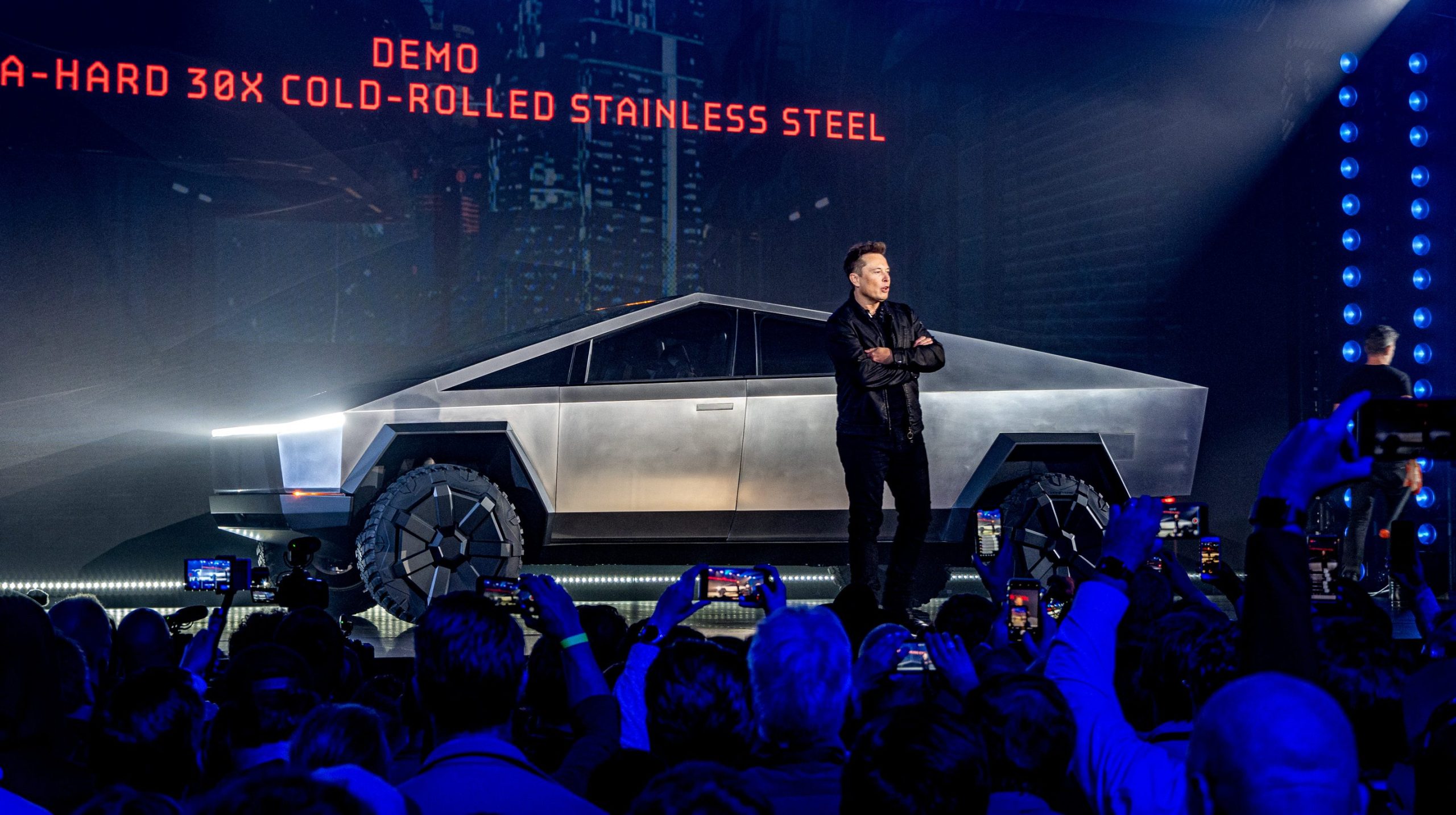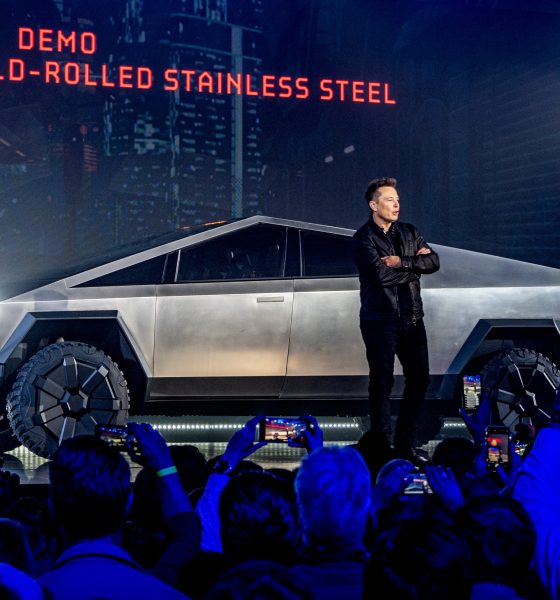

News
Tesla and Elon Musk won’t budge on what Cybertruck orderers want to hear
Yesterday, Tesla CEO Elon Musk teased the Cybertruck twice with two new images of a production candidate version of the all-electric pickup. Sightings of the Cybertruck have been plentiful through the past few months, but the real details that orderers want to hear are still being kept a mystery as the company and its CEO won’t budge on what they will be.
The Cybertruck is perhaps Tesla’s most anticipated vehicle in history. It was unveiled four years ago, and after delays and years of holdups in terms of development and production, Tesla is finally ready to begin deliveries by the end of the year.
However, the nearly two million people who have placed orders for the Cybertruck are still unsure what they will pay, what powertrain their truck will have, and when they will get it.
Tesla Cybertruck production candidate revealed by CEO Elon Musk
James Locke, a longtime Tesla owner, asked Musk yesterday when the company would release this information. “Enough with the hype, let’s get down to business,” he said, requesting any information on vehicle specs, pricing, and the delivery date event.
But Musk was unwilling to give that information, even still, as the Cybertruck nears initial deliveries.
“When we are ready to do so, we will,” he said. “While I think it is our best product ever, it is an extremely difficult product to build. We are in uncharted territory because it is not like anything else.”
Musk hammered this point home in an email to Tesla employees yesterday, which reminded production line associates, engineers, and others that their mistakes would be magnified due to the “bright metal” and “mostly straight edges” the Cybertruck design has.
“If LEGO and soda cans, which are very low cost, can do this, so can we,” Musk said.
In the four years since the Cybertruck was unveiled, a lot has changed, including the prices of vehicles. Mid-size pickups have increased from $33,262 in March 2019 to $41,176 in the same month in 2023. Full-sized trucks have swelled from $48,653 to $62,825, according to data from Kelley Blue Book.
Pricing is likely still up in the air, but Musk has hinted toward what potential Cybertruck pricing could be in the past. However, powertrains, at least for early vehicle builds, are more than likely finalized, and those who put a $100 deposit on the Cybertruck early on chose a specific configuration.
This option was eliminated a couple of years ago. Instead, Tesla simply allowed people to put money down, but there were no options for configurations.
We are getting down to the nitty-gritty with the Cybertruck, and with deliveries likely closing in within the next few months, people are still confused over what vehicle they will get and how much they will pay. If Tesla’s plan is to reveal this information at the delivery date, doesn’t that seem kind of late?
Nevertheless, the orderers of the Cybertruck are more than likely willing to give their money regardless, as they have been waiting patiently for the truck to be built and released for years.
Last night, we found out the Cybertruck Delivery Event would be held in Texas, and not Fremont, California, as batches of the pickup had been spotted at Tesla’s Northern California production facility.

Elon Musk
Elon Musk confirms xAI’s purchase of five 380 MW natural gas turbines
The deal, which was confirmed by Musk on X, highlights xAI’s effort to aggressively scale its operations.

xAI, Elon Musk’s artificial intelligence startup, has purchased five additional 380 MW natural gas turbines from South Korea’s Doosan Enerbility to power its growing supercomputer clusters.
The deal, which was confirmed by Musk on X, highlights xAI’s effort to aggressively scale its operations.
xAI’s turbine deal details
News of xAI’s new turbines was shared on social media platform X, with user @SemiAnalysis_ stating that the turbines were produced by South Korea’s Doosan Enerbility. As noted in an Asian Business Daily report, Doosan Enerbility announced last October that it signed a contract to supply two 380 MW gas turbines for a major U.S. tech company. Doosan later noted in December that it secured an order for three more 380 MW gas turbines.
As per the X user, the gas turbines would power an additional 600,000+ GB200 NVL72 equivalent size cluster. This should make xAI’s facilities among the largest in the world. In a reply, Elon Musk confirmed that xAI did purchase the turbines. “True,” Musk wrote in a post on X.
xAI’s ambitions
Recent reports have indicated that xAI closed an upsized $20 billion Series E funding round, exceeding the initial $15 billion target to fuel rapid infrastructure scaling and AI product development. The funding, as per the AI startup, “will accelerate our world-leading infrastructure buildout, enable the rapid development and deployment of transformative AI products.”
The company also teased the rollout of its upcoming frontier AI model. “Looking ahead, Grok 5 is currently in training, and we are focused on launching innovative new consumer and enterprise products that harness the power of Grok, Colossus, and 𝕏 to transform how we live, work, and play,” xAI wrote in a post on its website.
Elon Musk
Elon Musk’s xAI closes upsized $20B Series E funding round
xAI announced the investment round in a post on its official website.

xAI has closed an upsized $20 billion Series E funding round, exceeding the initial $15 billion target to fuel rapid infrastructure scaling and AI product development.
xAI announced the investment round in a post on its official website.
A $20 billion Series E round
As noted by the artificial intelligence startup in its post, the Series E funding round attracted a diverse group of investors, including Valor Equity Partners, Stepstone Group, Fidelity Management & Research Company, Qatar Investment Authority, MGX, and Baron Capital Group, among others.
Strategic partners NVIDIA and Cisco Investments also continued support for building the world’s largest GPU clusters.
As xAI stated, “This financing will accelerate our world-leading infrastructure buildout, enable the rapid development and deployment of transformative AI products reaching billions of users, and fuel groundbreaking research advancing xAI’s core mission: Understanding the Universe.”
xAI’s core mission
Th Series E funding builds on xAI’s previous rounds, powering Grok advancements and massive compute expansions like the Memphis supercluster. The upsized demand reflects growing recognition of xAI’s potential in frontier AI.
xAI also highlighted several of its breakthroughs in 2025, from the buildout of Colossus I and II, which ended with over 1 million H100 GPU equivalents, and the rollout of the Grok 4 Series, Grok Voice, and Grok Imagine, among others. The company also confirmed that work is already underway to train the flagship large language model’s next iteration, Grok 5.
“Looking ahead, Grok 5 is currently in training, and we are focused on launching innovative new consumer and enterprise products that harness the power of Grok, Colossus, and 𝕏 to transform how we live, work, and play,” xAI wrote.
Investor's Corner
Tesla gets price target bump, citing growing lead in self-driving

Tesla (NASDAQ: TSLA) stock received a price target update from Pierre Ferragu of Wall Street firm New Street Research, citing the company’s growing lead in self-driving and autonomy.
On Tuesday, Ferragu bumped his price target from $520 to $600, stating that the consensus from the Consumer Electronics Show in Las Vegas was that Tesla’s lead in autonomy has been sustained, is growing, and sits at a multiple-year lead over its competitors.
CES 2026 validates Tesla’s FSD strategy, but there’s a big lag for rivals: analyst
“The signal from Vegas is loud and clear,” the analyst writes. “The industry isn’t catching up to Tesla; it is actively validating Tesla’s strategy…just with a 12-year lag.”
The note shows that the company’s prowess in vehicle autonomy is being solidified by lagging competitors that claim to have the best method. The only problem is that Tesla’s Vision-based approach, which it adopted back in 2022 with the Model 3 and Model Y initially, has been proven to be more effective than competitors’ approach, which utilizes other technology, such as LiDAR and sensors.
Currently, Tesla shares are sitting at around $433, as the company’s stock price closed at $432.96 on Tuesday afternoon.
Ferragu’s consensus on Tesla shares echoes that of other Wall Street analysts who are bullish on the company’s stock and position within the AI, autonomy, and robotics sector.
Dan Ives of Wedbush wrote in a note in mid-December that he anticipates Tesla having a massive 2026, and could reach a $3 trillion valuation this year, especially with the “AI chapter” taking hold of the narrative at the company.
Ives also said that the big step in the right direction for Tesla will be initiating production of the Cybercab, as well as expanding on the Robotaxi program through the next 12 months:
“…as full-scale volume production begins with the autonomous and robotics roadmap…The company has started to test the all-important Cybercab in Austin over the past few weeks, which is an incremental step towards launching in 2026 with important volume production of Cybercabs starting in April/May, which remains the golden goose in unlocking TSLA’s AI valuation.”
Tesla analyst breaks down delivery report: ‘A step in the right direction’
Tesla has transitioned from an automaker to a full-fledged AI company, and its Robotaxi and Cybercab programs, fueled by the Full Self-Driving suite, are leading the charge moving forward. In 2026, there are major goals the company has outlined. The first is removing Safety Drivers from vehicles in Austin, Texas, one of the areas where it operates a ride-hailing service within the U.S.
Ultimately, Tesla will aim to launch a Level 5 autonomy suite to the public in the coming years.








